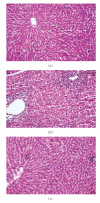Lycopene prevents development of steatohepatitis in experimental nonalcoholic steatohepatitis model induced by high-fat diet
- PMID: 20953409
- PMCID: PMC2952801
- DOI: 10.4061/2010/262179
Lycopene prevents development of steatohepatitis in experimental nonalcoholic steatohepatitis model induced by high-fat diet
Abstract
We investigated the preventive effect of lycopene on nonalcoholic steatohepatitis-induced by high-fat diet in rats. Forty male Sprague-Dawley rats were divided into 4 groups. They were fed standard diet, high-fat diet (HFD), high-fat diet plus lycopene at a dose of 2 mg/kg body weight and the high-fat diet lycopene at a dose of 4 mg/kg BW for a period of 6 weeks. Inflammation, steatosis, α-smooth muscle actin (α-SMA), and cytochrome P450 2E1 (CYP 2E1) expression increased significantly in the rats fed HFD and decreased in the rats administered by lycopene. Significantly elevated levels of serum alanine aminotransferase (ALT), aspartate aminotransferase (AST), tumor necrosis factor (TNF α), and serum and liver malondialdehyde (MDA) were observed in rats fed the high-fat diet as compared to the control rats (P < .01). Supplementation with lycopene lowered serum MDA and tumor necrosis factor (TNF-α) levels and elevated liver GSH level (P < .001). Insulin resistance was higher in the rats fed HFD than in rats supplemented with lycopene. The data indicate that supplementation with lycopene can reduce high-fat diet-induced oxidative stress to the cells.
Figures


Similar articles
-
Epigallocatechin gallate attenuates experimental non-alcoholic steatohepatitis induced by high fat diet.J Gastroenterol Hepatol. 2008 Aug;23(8 Pt 2):e465-70. doi: 10.1111/j.1440-1746.2007.05052.x. Epub 2007 Aug 6. J Gastroenterol Hepatol. 2008. PMID: 17683497
-
Amelioration of steatohepatitis with pentoxifylline in a novel nonalcoholic steatohepatitis model induced by high-fat diet.Dig Dis Sci. 2007 Sep;52(9):2380-6. doi: 10.1007/s10620-006-9194-1. Epub 2007 Apr 6. Dig Dis Sci. 2007. PMID: 17415655
-
Probucol ameliorates the development of nonalcoholic steatohepatitis in rats fed high-fat diets.Dig Dis Sci. 2013 Jan;58(1):163-71. doi: 10.1007/s10620-012-2335-9. Epub 2012 Aug 10. Dig Dis Sci. 2013. PMID: 22878918
-
Addition of trans fat and alcohol has divergent effects on atherogenic diet-induced liver injury in rodent models of steatohepatitis.Am J Physiol Gastrointest Liver Physiol. 2020 Mar 1;318(3):G410-G418. doi: 10.1152/ajpgi.00066.2019. Epub 2020 Jan 6. Am J Physiol Gastrointest Liver Physiol. 2020. PMID: 31905026
-
Hepatoprotective and antioxidant effects of lycopene on non-alcoholic fatty liver disease in rat.World J Gastroenterol. 2016 Dec 14;22(46):10180-10188. doi: 10.3748/wjg.v22.i46.10180. World J Gastroenterol. 2016. PMID: 28028366 Free PMC article.
Cited by
-
Protective effect of lycopene on oral mucositis and antioxidant capacity of blood plasma in the rat exposed to gamma radiation.Caspian J Intern Med. 2020 Fall;11(4):419-425. doi: 10.22088/cjim.11.4.419. Caspian J Intern Med. 2020. PMID: 33680384 Free PMC article.
-
The Potential of Non-Provitamin A Carotenoids for the Prevention and Treatment of Non-Alcoholic Fatty Liver Disease.Biology (Basel). 2016 Nov 8;5(4):42. doi: 10.3390/biology5040042. Biology (Basel). 2016. PMID: 27834813 Free PMC article. Review.
-
Lycopene Improves Metabolic Disorders and Liver Injury Induced by a Hight-Fat Diet in Obese Rats.Molecules. 2022 Nov 10;27(22):7736. doi: 10.3390/molecules27227736. Molecules. 2022. PMID: 36431836 Free PMC article.
-
Lycopene: a therapeutic strategy against coronavirus disease 19 (COVID- 19).Inflammopharmacology. 2022 Dec;30(6):1955-1976. doi: 10.1007/s10787-022-01061-4. Epub 2022 Sep 1. Inflammopharmacology. 2022. PMID: 36050507 Free PMC article. Review.
-
Adherence to Mediterranean Diet: Any Association with NAFLD?Antioxidants (Basel). 2023 Jun 21;12(7):1318. doi: 10.3390/antiox12071318. Antioxidants (Basel). 2023. PMID: 37507858 Free PMC article.
References
-
- Ludwig J, Viggiano TR, McGill DB, Ott BJ. Non-alcoholic steatohepatitis. Mayo Clinic experiences with a hitherto unnamed disease. Mayo Clinic Proceedings. 1980;55(7):434–438. - PubMed
-
- James OFW, Day CP. Non-alcoholic steatohepatitis (NASH): a disease of emerging identity and importance. Journal of Hepatology. 1998;29(3):495–501. - PubMed
-
- Matteoni CA, Younossi ZM, Gramlich T, Boparai N, Liu YC, McCullough AJ. Non-alcoholic fatty liver disease: a spectrum of clinical and pathological severity. Gastroenterology. 1999;116(6):1413–1419. - PubMed
-
- Brunt EM, Janney CG, Di Bisceglie AM, Neuschwander-Tetri BA, Bacon BR. Nonalcoholic steatohepatitis: a proposal for grading and staging the histological lesions. American Journal of Gastroenterology. 1999;94(9):2467–2474. - PubMed
-
- Paradis V, Perlemuter G, Bonvoust F, et al. High glucose and hyperinsulinemia stimulate connective tissue growth factor expression: a potential mechanism involved in progression to fibrosis in nonalcoholic steatohepatitis. Hepatology. 2001;34(4):738–744. - PubMed
LinkOut - more resources
Full Text Sources
Other Literature Sources

